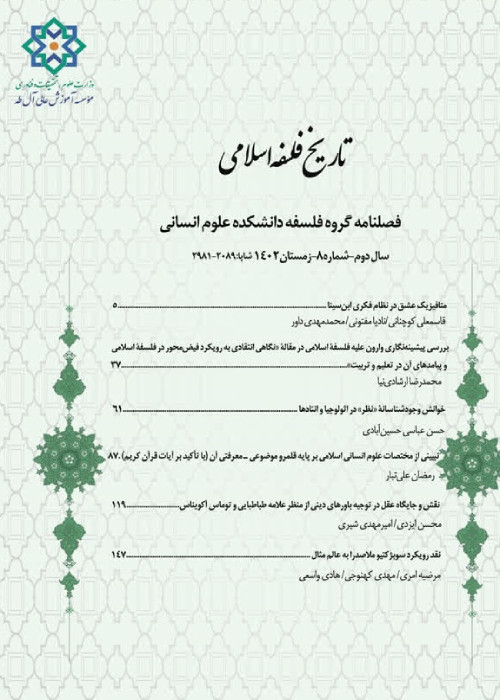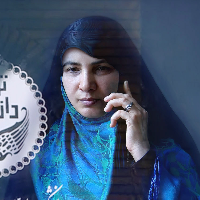The Metaphysics of Love in Avicenna’s Philosophical System
Author(s):
Article Type:
Research/Original Article (دارای رتبه معتبر)
Abstract:
The metaphysical concept of love in Sinawi philosophy examines the three axes of the essence, reason, and manner of love in Avicenna’s intellectual system, resulting in Avicenna’s theory of love. By examining Avicenna’s views on love, particularly in his treatise on love, it can be understood that he has presented two definitions of love (essence), and in the seven chapters of the treatise on love, he admits that love is a pervasive essential substance throughout existence, and no creature is devoid of this substance. It can, therefore, be argued that love is the cause of the existence of creatures (reason). On the other hand, Avicenna has also explained the flow and dependence of creatures on love under each chapter (manner). The result of understanding and examining these three axes in Avicenna’s views, which is the goal of this research, has led to the theory of Sinawi love, which shows Avicenna’s worldview on love.IntroductionAvicenna is one of the philosophers who has discussed love in various contexts, and it must be claimed that his views on this matter are exemplary. We can extract Avicenna’s theory of love from his opinions. What emerges from Avicenna’s ontology of love is the same theory of love that can be placed alongside erotic love and Platonic love. In other phrases, just as erotic love and Platonic love are recognized as two approaches and theories in the discussion of love, Avicenna’s love will also be a worldview about love and can be recognized as an independent approach in the world of thought. The love found in Avicenna’s intellectual system is a gem that flows and permeates throughout the universe, and the existence and survival of all beings depend on this substance. Our intention in using the term "metaphysics of love" or, in other words, the ontology of love, is precisely this: why and how the existence and survival of beings are dependent on love, and why and how love flows through all existence. The sum of these questions constitutes the main issue of our research. Therefore, the fundamental problem of our research is the metaphysics or ontology of love, which consists of the following four questions as the elements of this issue: 1. Why are the existence of beings dependent on love? 2. How is the existence of beings dependent on love? 3. Why does love flow and permeate throughout all existence? 4. How does love flow and permeate throughout all existence? MethodThe answer to the questions present in our issue is essentially the expression of the metaphysics of love, which we have referred to as "sinawi love" or "Avicennian love" as a concise term for the metaphysics of love in the philosophical system of Avicenna. FindingsBased on this, the metaphysics of love in the philosophy of Avicenna is established on three axes: essence, causality, and modality. In the axis of essence, we express what love is and perform a sort of ontology of love. In causality, we must answer the question of why love is the cause of existence and the survival of beings, flowing throughout the entire universe (i.e., the first and third questions). In modality, we need to examine how the existence of beings is dependent on love and how love flows and permeates throughout the entire world. The ontology of love and the expression of the definition of love according to Avicenna can be approached from both a direct and an indirect perspective, and in both approaches, it can be argued that love is a pervasive essence throughout the universe and present in all beings, and the existence of all beings is dependent on love. In regards to the causality of the existence of love, it must be stated that the reason for the existence and survival of beings is possibly rooted in love. In the first chapter of the treatise, it is mentioned that all possibilities have love because they have an inclination to preserve their perfection and also have a desire to acquire other perfections. Thus, they all possess love, and this love flows throughout all possibilities. In the second to sixth chapters of the treatise, the love of possibilities is specifically discussed, and by examining these chapters, we find that love exists among all vegetative and animal powers (both theoretical and practical), and even divine souls, as they recognize goodness and benefit, are inclined towards love for their own benefit. In the seventh chapter, it is also stated that all beings naturally have love for their own good and benefit, and they also love the manifestation of the Necessary of Existence as they recognize it through their own perfection. ConclusionIt becomes evident that the causality of the existence of love among possibilities is for their existence and survival, and the causality of the existence of love in the Necessary Being is the love for the manifestation of itself. The causality of the flow and permeation of love is such that all possibilities have a tendency towards the perfection of love, and this love, as we participate in it, has become universal among possibilities. The Necessary existence also desires its own manifestation; hence the flow of love is not limited to possibilities alone but encompasses the entirety of existence. The existence of love is described as follows: all beings, including contingent and necessary existences, are in love, and love flows throughout all of existence. Contingent beings have love for the preservation of perfection or the desire to acquire perfection. Vegetative and animal powers are always in love with their desired objects. The love of vegetative powers is natural, while the love of animal powers is voluntary in terms of action but considered natural in terms of purpose. On the other hand, human love and divine souls are considered voluntary in action and ultimate purpose. High and divine souls, due to their perception of the three mentioned elements, are in love with the necessary existence. Furthermore, all contingent beings, in addition to their love for perfection, naturally love the transcendent necessary existence. By examining Avicenna’s perspective on the nature of love and the reasons and ways of its existence in beings, as well as its flow throughout the entire universe, it can be claimed that the metaphysics of love, which encompasses these three aspects, is the theory of love according to Avicenna. In doing so, Avicenna’s conception of love, both in terms of definition and existence, aligns with the theory of love proposed by Avicenna, and further exploration of the elements of this theory will lead to its expansion.
Keywords:
Language:
Persian
Published:
Journal of The History of Islamic Philosophy, Volume:2 Issue: 8, 2024
Pages:
5 to 36
magiran.com/p2704985
دانلود و مطالعه متن این مقاله با یکی از روشهای زیر امکان پذیر است:
اشتراک شخصی
با عضویت و پرداخت آنلاین حق اشتراک یکساله به مبلغ 1,390,000ريال میتوانید 70 عنوان مطلب دانلود کنید!
اشتراک سازمانی
به کتابخانه دانشگاه یا محل کار خود پیشنهاد کنید تا اشتراک سازمانی این پایگاه را برای دسترسی نامحدود همه کاربران به متن مطالب تهیه نمایند!
توجه!
- حق عضویت دریافتی صرف حمایت از نشریات عضو و نگهداری، تکمیل و توسعه مگیران میشود.
- پرداخت حق اشتراک و دانلود مقالات اجازه بازنشر آن در سایر رسانههای چاپی و دیجیتال را به کاربر نمیدهد.
In order to view content subscription is required
Personal subscription
Subscribe magiran.com for 70 € euros via PayPal and download 70 articles during a year.
Organization subscription
Please contact us to subscribe your university or library for unlimited access!




